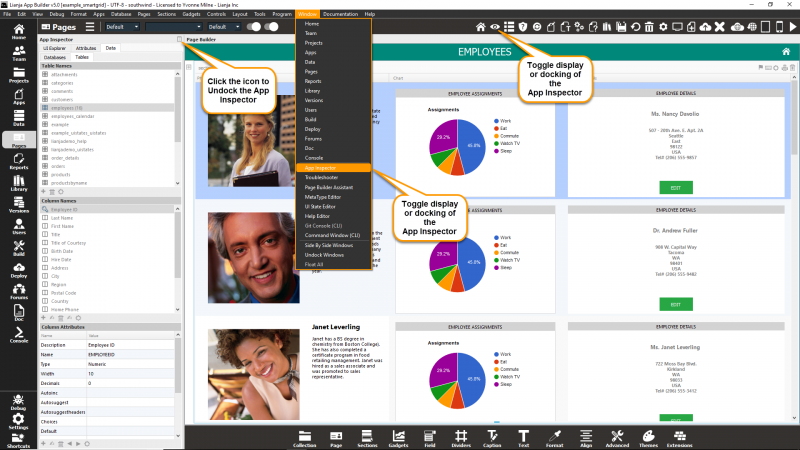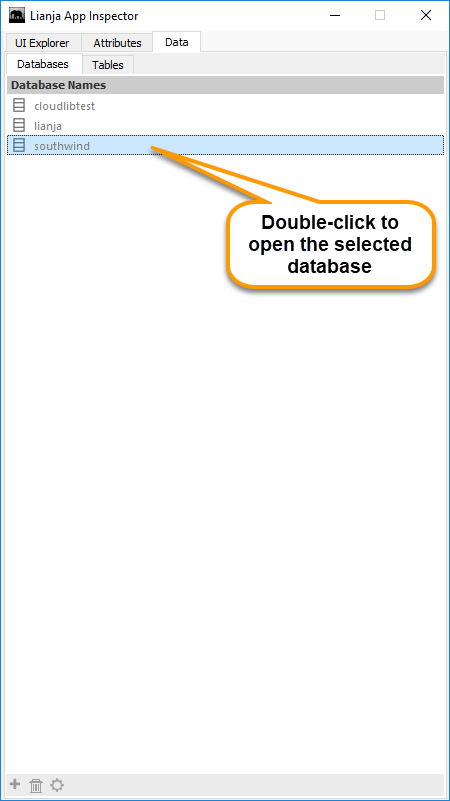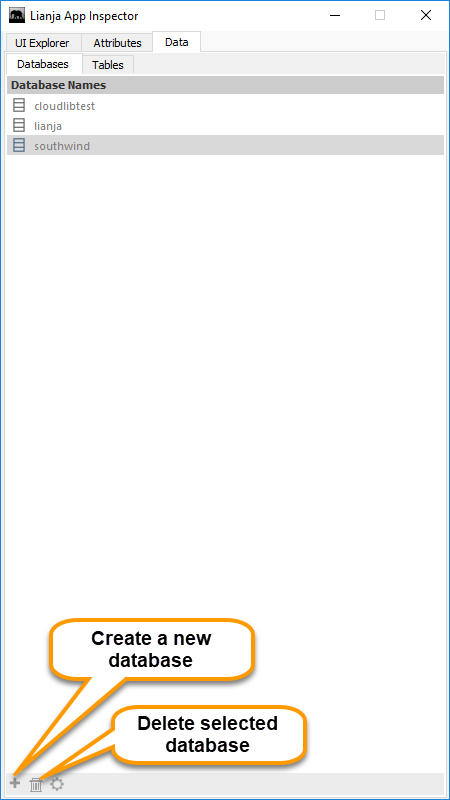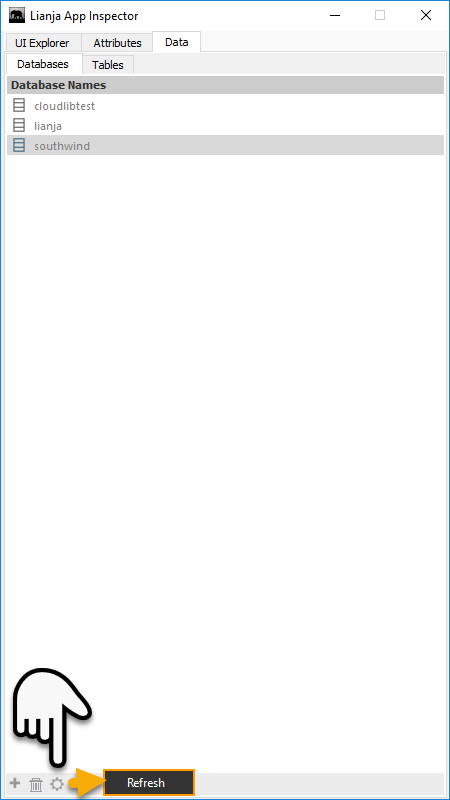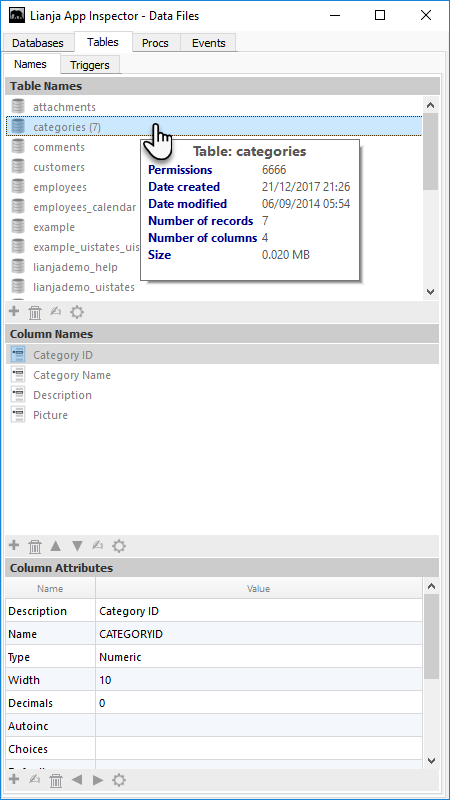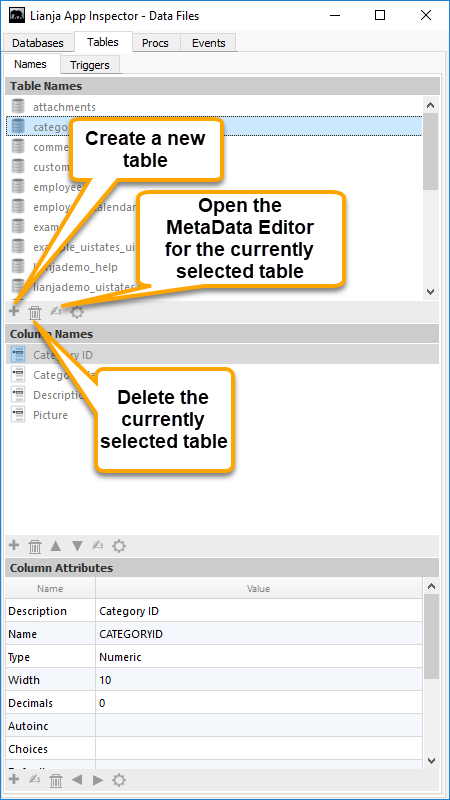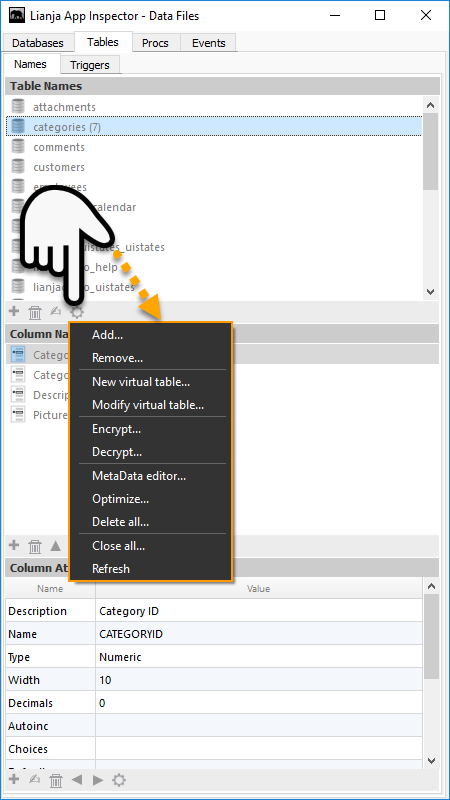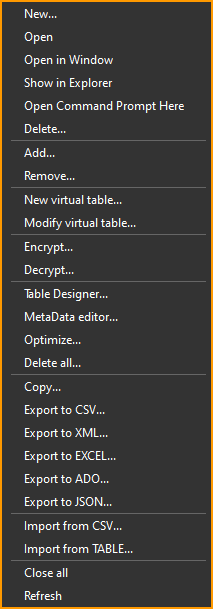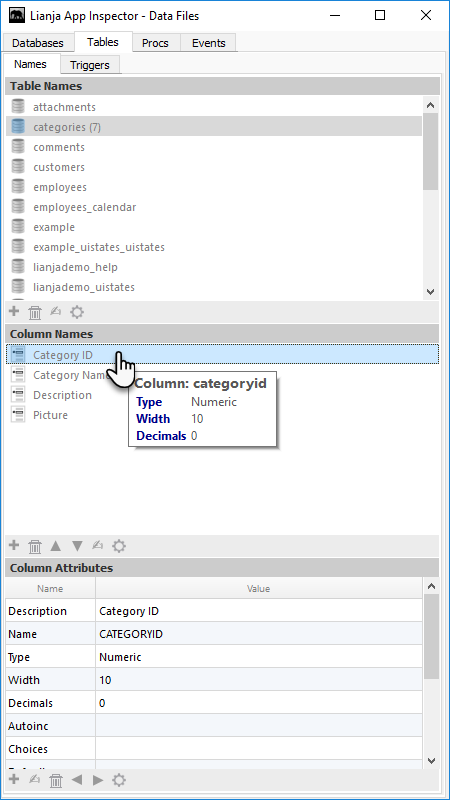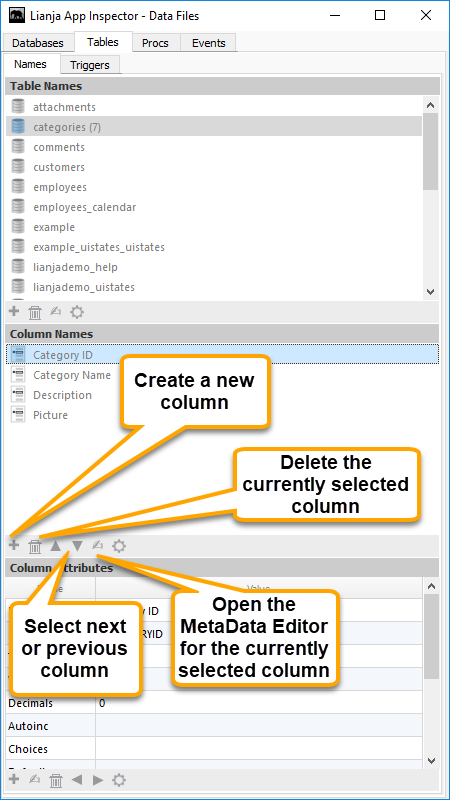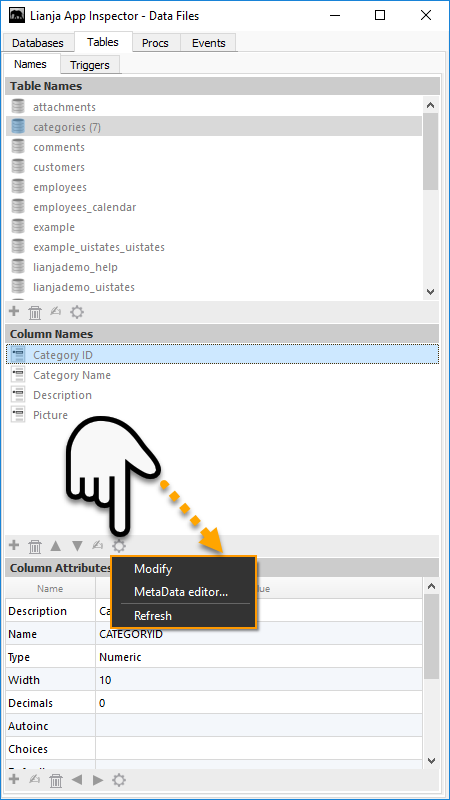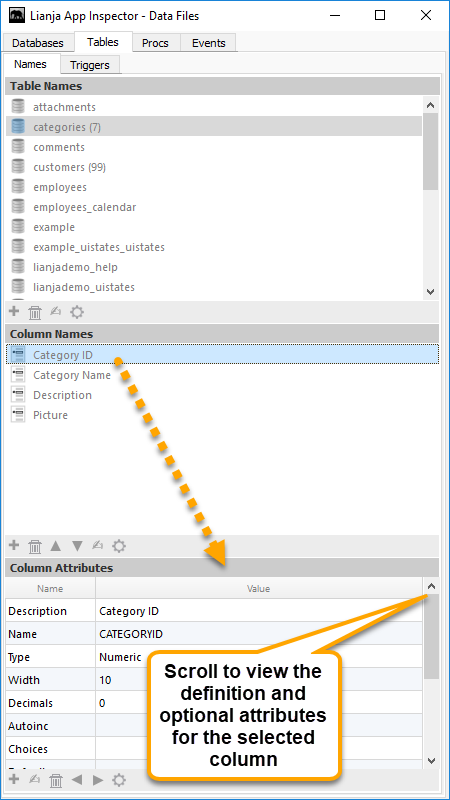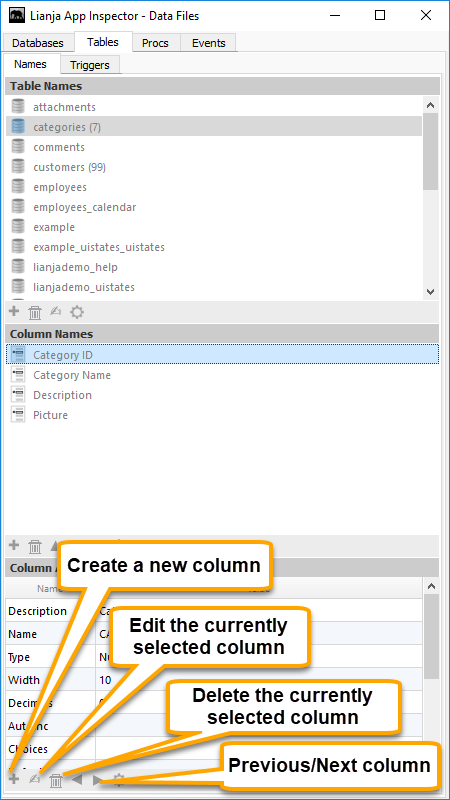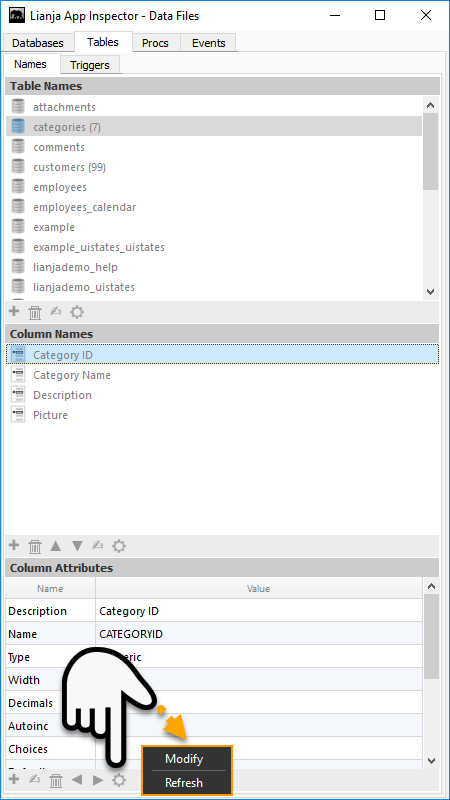Difference between revisions of "Data"
Yvonne.milne (Talk | contribs) |
Yvonne.milne (Talk | contribs) (→The Data Tab) |
||
| Line 12: | Line 12: | ||
==The Data Tab== | ==The Data Tab== | ||
| − | The Data Tab contains file lists for the current App's data files. | + | The Data Tab contains file lists for the current App's data files. It appears in the App Inspector when the Pages Workspace is active. |
===Databases=== | ===Databases=== | ||
Revision as of 10:46, 22 May 2019
Under Construction. Coming soon in Lianja v5.0
The App Inspector
The App Inspector display changes based on the current workspace, showing tabs relevant to that workspace.
Clicking the small icon on the far right of the App Inspector title bar will detach it into its own floating window.
Double clicking the window title bar when it is floating will attach it back into place.
The Data Tab
The Data Tab contains file lists for the current App's data files. It appears in the App Inspector when the Pages Workspace is active.
Databases
The Databases tab contains the Database Names panel with a list of available databases.
Note: opening a database is not available when an App that already has an associated database is open.
If you have a project open you will only see the databases that have been added to that project.
Actionbar
From the actionbar you can:
- Create a New database. This option is not available when an App that already has an associated database is open.
- Delete the currently selected database. This option is not available when an App is open or the selected database is open. You will be prompted to confirm the operation.
- Open the MetaData editor for the currently selected database. See MetaData Editor for information.
- Access Additional Commands by clicking the cog button.
Additional Commands
| Menu Option | More Information |
|---|---|
| Refresh | Refreshes the database panel. |
Tables
Click on a table name in the Tables panel to select it and display its columns and their attributes in the lower panels.
Table Names
Hover the mouse over a table name row to display information about the table:
Actionbar
From the actionbar you can:
- Create a New table. This will open the CREATE A TABLE dialog.
- Delete the currently selected table. You will be prompted to confirm the operation.
- Open the MetaData editor for the currently selected table. See MetaData Editor for information.
- Access Additional Commands by clicking the cog button.
Additional Commands
| Menu Option | More Information |
|---|---|
| Add... | Adds a table to the current database. This will open the Select a table dialog allowing you to select an existing table to add to the database. See also ADD TABLE. |
| Remove... | Removes the table from the current database. It does not delete the table. You will be prompted to confirm the operation.
See also REMOVE TABLE. |
| New virtual table... | Creates a new virtual table in the current database. You will be prompted to enter a name for the new virtual table, then the CREATE A VIRTUAL TABLE dialog will be displayed to allow you to configure the virtual table. |
| Modify virtual table... | Modifies the currently selected virtual table. This option is not available when a native table is selected. The MODIFY A VIRTUAL TABLE dialog will be displayed to allow you to modify the virtual table. |
| Encrypt... | Encrypts the currently selected table. See Encryption. |
| Decrypt... | Decrypts the currently selected table. See Encryption. |
| MetaData editor... | Opens the MetaData editor for the currently selected table. See MetaData Editor for information. |
| Optimize... | Optimizes the currently selected table. This option is not available when an App is open. |
| Delete all... | Deletes all the records in the currently selected table (ZAP). This option is not available when an App is open. |
| Close all... | Closes all the tables. This option is not available when an App is open. |
| Refresh | Refreshes the Table Names panel. |
Context Menu
| Menu Option | More Information |
|---|---|
| New... | Creates a New table. This will open the CREATE A TABLE dialog. |
| Open | Opens the currently selected table in the Data Editor in the Data Workspace. Note that this operation is not available when an App is open. |
| Open in Window | Opens the currently selected table in the Data Editor in the a floating window. Note that this operation is not available when an App is open. |
| Show in Explorer | Opens the location of the currently selected table in the operating system file explorer. |
| Open Command Prompt Here | Opens an operating system command prompt in the current database's directory. |
| Delete... | Deletes the currently selected table. You will be prompted to confirm the operation. |
| Add... | Adds a table to the current database. This will open the Select a table dialog allowing you to select an existing table to add to the database. See also ADD TABLE. |
| Remove... | Removes the table from the current database. It does not delete the table. You will be prompted to confirm the operation.
See also REMOVE TABLE. |
| New virtual table... | Creates a new virtual table in the current database. You will be prompted to enter a name for the new virtual table, then the CREATE A VIRTUAL TABLE dialog will be displayed to allow you to configure the virtual table. |
| Modify virtual table... | Modifies the currently selected virtual table. This option is not available when a native table is selected. The MODIFY A VIRTUAL TABLE dialog will be displayed to allow you to modify the virtual table. |
| Encrypt... | Encrypts the currently selected table. See Encryption. |
| Decrypt... | Decrypts the currently selected table. See Encryption. |
| MetaData editor... | Opens the MetaData editor for the currently selected table. See MetaData Editor for information. |
| Optimize... | Optimizes the currently selected table. This option is not available when an App is open. |
| Delete all... | Deletes all the records in the currently selected table (ZAP). This option is not available when an App is open. |
| Close all... | Closes all the tables. This option is not available when an App is open. |
| Refresh | Refreshes the Table Names panel. |
Column Names
The middle panel in the Names tab displays the columns from the currently selected table. Double-click on a column name to open it in the MODIFY A COLUMN dialog so you can modify its definition and/or attributes.
Hover the mouse over a column name row to display information about the column:
Actionbar
From the actionbar you can:
- Create a New column. This opens the CREATE A COLUMN dialog
- Delete the currently selected column. You will be prompted to confirm the operation.
- Navigate between the columns.
- Open the MetaData editor for the currently selected column. See MetaData Editor for information.
- Access Additional Commands by clicking the cog button.
Additional Commands
| Menu Option | More Information |
|---|---|
| Modify | Opens the MODIFY A COLUMN dialog for the currently selected column. |
| MetaData editor... | Opens the MetaData editor for the currently selected column. See MetaData Editor for information. |
| Refresh | Refreshes the Column Names panel. |
Column Attributes
The bottom panel in the Names tab displays the definition and optional attributes for the currently selected column.
Actionbar
From the actionbar you can:
- Create a New column. This opens the CREATE A COLUMN dialog
- Edit the currently selected column. This opens the MODIFY A COLUMN dialog
- Delete the currently selected column. You will be prompted to confirm the operation.
- Navigate between the columns.
- Access Additional Commands by clicking the cog button.
Additional Commands
| Menu Option | More Information |
|---|---|
| Modify | Opens the MODIFY A COLUMN dialog for the currently selected column. |
| Refresh | Refreshes the Column Attributes panel. |
